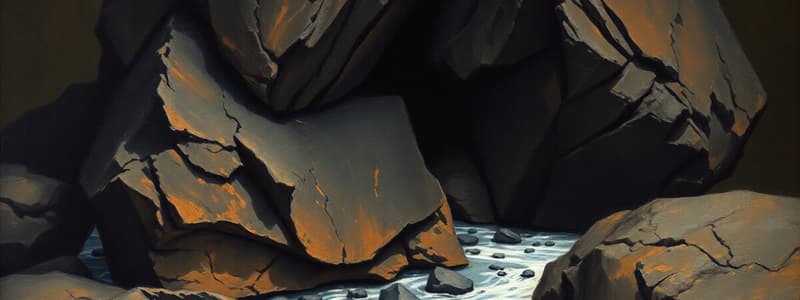Podcast
Questions and Answers
What is the main difference between intrusive and extrusive igneous rocks?
What is the main difference between intrusive and extrusive igneous rocks?
- Intrusive rocks cool and crystallize within the Earth's crust, while extrusive rocks cool and crystallize at the surface. (correct)
- Intrusive rocks cool at the surface, while extrusive rocks cool underground.
- Intrusive rocks contain more fossil evidence than extrusive rocks.
- Intrusive rocks form from lava flows, while extrusive rocks form from magma.
Which of the following characteristics is NOT typical of igneous rocks?
Which of the following characteristics is NOT typical of igneous rocks?
- Presence of fossils. (correct)
- Formation from magma.
- Structureless anatomy.
- Interlocking grains.
At what approximate temperature do rocks begin to melt, leading to the formation of magma?
At what approximate temperature do rocks begin to melt, leading to the formation of magma?
- 500°C
- 1100°C
- 700°C (correct)
- 900°C
Which of the following structures is characteristic of intrusive igneous rocks?
Which of the following structures is characteristic of intrusive igneous rocks?
Where are igneous rocks primarily located in geological formations?
Where are igneous rocks primarily located in geological formations?
Study Notes
Igneous Rocks: General Information
- Rocks are naturally formed solid materials made up of one or more minerals.
- Rocks can be classified into three types:
- Igneous
- Sedimentary
- Metamorphic
Igneous Rocks - General Information
- Igneous rocks are formed from the crystallization of minerals from magma as it cools.
- Igneous rocks are commonly found in association with volcanoes and related lava flows.
- They are often found cutting across existing rocks, indicating their intrusive origin.
- Igneous rocks exhibit thermal effects on surrounding rocks, indicating heat transfer from the magma.
- They generally lack fossils and stratification.
- They are typically structureless, composed of interlocking mineral grains.
- Predominantly located in Precambrian or orogenic terrains.
- Igneous rocks occur in distinctive shapes and forms, such as sills, stocks, batholiths, and lava flows.
Magma and Igneous Rocks
- Magmas originate deep within the Earth's crust and upper mantle.
- Rocks with temperatures around 700°C can begin to melt, with the exact melting point varying depending on the chemical composition of the rock.
Intrusive vs. Extrusive Rocks
- Intrusive rocks form when magma cools and crystallizes within the Earth's crust.
- Extrusive rocks form when magma cools and crystallizes at the Earth's surface.
- Pink granite is an example of an intrusive rock.
- Rounded spindle bombs are an example of an extrusive rock.
Studying That Suits You
Use AI to generate personalized quizzes and flashcards to suit your learning preferences.
Related Documents
Description
This quiz covers the essential characteristics and formation of igneous rocks. Learn about how these rocks form from magma, their classification, and their distinct features. Dive into the fascinating world of geology and understand the role of igneous rocks in Earth's structure.



